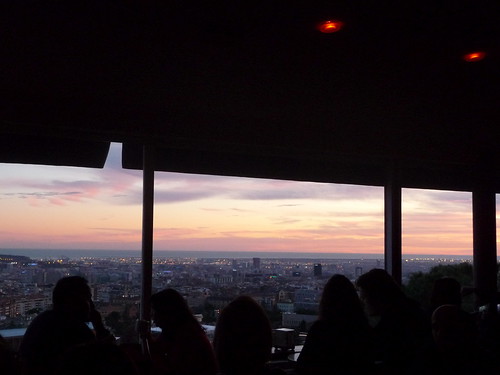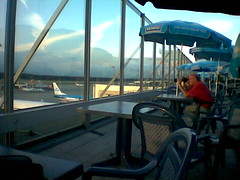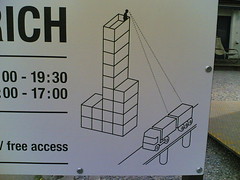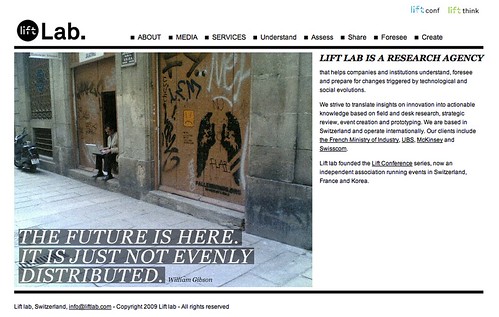Posted: December 28th, 2009 | No Comments »

Mirablau at the bottom of Tibidabo offers a spectacular view over Barcelona. At sunset, the lights are soften to contemplate the change of colors of the city.
Why do I blog this: Working on a text on data cities and visualization. I communicate my work with visualization to play with this fascination of the macro views on city dynamics. Most cities offer their observation decks, being it natural or man made. They complement the citizens mundane micro observations of atomic level city dynamics (e.g. planes, road traffic, construction sites, …)



Posted: December 28th, 2009 | 4 Comments »
The increasing presence of soft infrastructures embedded with the urban fabric is altering our experience of the city. Simultaneously, the manipulation and processing of the underlying data generated by networked and sentient systems offers new possibilities for architecture. Yet, there seems to be a gap in the practice of designing buildings and spaces in concert with their informational membrane; a practices that understands what makes good cities tick and knows the roles informatics can (and cannot) play; a practice between architecture of construct, architecture of information and industrial/experience/interaction design. The gap seems so wide that large software and hardware corporations are the sole actors that attempt projecting their visions and deploy their case studies of smarter/sentient/responsive cities. This year’s Toward the Sentient City organized by the Architectural League of New York has been an attempt of to fill the void and look at the possible future trajectory for architecture at the time of urban informatics. In his constructive criticism of the show, Dan Hill highlighted how far architecture has to go to stay relevant in the development of ’sentient cities’:
Architecture and urban design should be in this debate, no doubt, but its entire practice, sensibility and economic model may need redressing (as with many other fields, of course.) Given their previous predilections, the lack of technical and conceptual understanding – never mind an apparently congenital inability to design a decent website – the profession has a long way to go before it can demand a seat at the table. An admittedly fading tradition of thinking of itself as the ‘master builder’ needs to be entirely excoriated once and for all.
In a recent keynote address entitled “How can architects relate to digital media?” Mobile City’s Michiel de Lange and Martijn de Waal urged a parterre of young architects to “relate to digital media in a new way, beyond merely using them as instruments, to represent their spatial logic in design, or to design for virtual worlds“. They layout a couple of new directions in the evolution of architecture as a practice:
First, we already witness that the profession is flexibly adapting itself to new circumstances. Architecture is moving in the direction of what has been called ‘service design’. This means that a client hires a ‘designer’ not to just build him a beautiful building, but to shape a particular process or ‘customer (or ‘citizen’) experience’ from start to end. The question is how can these two structures – physical situations and media practices – be combined to design for urban experiences in meaningful ways? Surely this question cannot be solved by architects alone.
Second, architects harness spatial expertise that can steer future directions of new media. Digital media developments are increasingly being integrated with geographical space, physical context, and the material world (labelled geo-spatial web, locative media, the internet of things, and so on). We think it is important that architects play a role in the debate about the values that are implied in such media designs.
Architects can contribute crucial insights particularly on the non-digital modes of design for human experience (see Responsive Environments), the kind of insights based on historical context that other practices fail to grasp. For instance, Adam Greenfield recently discussed the ahistoricity of interaction design:
Let’s face it: brighter and more sensitive people than us have been thinking about issues like public versus private realms, or which elements of a system are hard to reconfigure and which more open to user specification, for many hundreds of years. Medieval Islamic urbanism, for example, had some notions about how to demarcate transitional spaces between public and fully private that might still usefully inform the design of digital applications and services. By contrast, the level of sophistication with which those of us engaged in such design generally handle these issues is risible (and here I’m pointing a finger at just about the entire UX “community” and the technology industry that supports it).
Why do I blog this: Currently helping setting up an event that look at the new roles of architecture and urbanism in the networked cities landscape. I am particularly fascinated by the gap formed by the lack of technical and conceptual understanding of many architects and the little presence of historical context and acquaintance non-digital modes of design in the designers/engineers practices. A serious need for more T-shaped people?
Posted: December 23rd, 2009 | No Comments »
Barcelona has long and unique urban tradition often described as the “Modelo Barcelona” (see El Modelo Barcelona: un examen crítico) that features a capacity to treat and revitalize central urban space with interventions at the scale of streets and places; mixing with large urban projects that favor the density and compactness of urban form (see Barcelona: The Urban Evolution of a Compact City and the Barcelona Regeneration Model)and affect the city as a whole. The most apparent trace of its application are the garden city expansion of 520 street blocks planned as long ago as 1859 by Ildefons Cerdà (Plan Cerdà) now forming the Eixample district and the use of the Olympic Games as a vehicle for city-wide reforms over four neglected urban areas. In the past decade, Barcelona has undergone a new wave of major transformation with the 22@ innovation area and the Diagonal Mar hyper-community constructed on coastal brownfield and reclaimed land. These evolutions have faced major criticisms to the points of wondering whether Barcelona was losing touch with its model that beyond strict urban planning is also associated with focus on civil society as the leading dynamic in the city’s evolution. For instance, Josep Lluis Mateo of the newly created Barcelona Institute of Architecture (BIArch) claims that the history of the practice of architecture in Barcelona is more advanced than the “Modelo Barcelona” and its recent use of iconic architecture, suggesting that forms matter less than space, material, light, sensations and logic (see “Reinventaremos el modelo Barcelona“).
While in the past architects and city planners might have argued and developed the model of Barcelona, new actors are emerging as driving forces of the evolution of the city, its infrastructure and quality of life. For instance, the innovation and eGovernment Department at Barcelona City Council has unveiled their “Smart City” model for using information and communication technologies to improve its residents’ quality of life and ensure more efficient and sustainable maintenance and management of big cities. Even if their “formula” is still fresh and goes through constant evolution it has reached enough maturity to contrast with very developed discourses on networked cities in Asia (with New Songdo as showcase) and the recent fascination of North America for open data initiatives (some carrying a similar tone of naiveness of the first wave of “Muni WiFi” projects).
In his presentation “Barcelona Smart City” (slides), Joan Batlle highlights the articulation of the four major connected elements of their model:
-
Ubiquitous infrastructures: city network, citizens’ access network (communicate and create information). Examples: Muni WiFi mesh network (680 nodes, 20 services, 500 free hotspots)
Information: sensors, digital footprints, citizens’ information (raw material of the innovation factories). Examples: BitCarrier’s real-time traffic monitoring system, my visualizations of Bicing and Flickr data, aggregated mobile network traffic data. Joan rightfully questions “Can we use Directive 2006/24/EC to devolve citizens’ information to citizens? …and allow them to make services for the citizens (from the citizens)?”
Living labs, open innovation: citizens, companies, universities, city council. Example: Urban labs at 22@ as testing space for innovative enterprises, Living labs with its Media-TIC building.
Smart Services: municipal advanced services, services for citizens from citizens. Example: iBicing for iPhone, and the Urban Mediator, one “click” services.
It will certainly be interesting to participate in the integration and interplay of this kind of Networked City model (extended by other initiatives such as Citilab) within the urban planning history of “Modelo Barcelona” that shows how the city has overcome major contradictions. Barcelona has the opportunity to be a leading city in that domain, with a sensitivity for its citizens, civil society and networks (a legacy of Manuel Castells?) over the concrete and the forms. It contrasts with many other European cities such as Paris and its famous Greater Paris design competition and Christian de Portzamparc’s project on efficiency and speed featuring some sort of paleo-futuristic Monorail.
Why do I blog this: My presence in Barcelona is partially the fruit of the 22@ urban project, because I preferred to pursue a PhD within the living lab and messy aspect of Barcelona rather than the green alleys of traditional university campuses. In return, my research projects are now presented as ground for potential future of the city. This is utterly rewarding and of course it incites me in intensifying my investigation in Barcelona.
I consider cities as being “smart” by default (isn’t it the human’s greatest invention?), so I do not support the contemporary discourse that information technologies and infrastructures will make them any smarter, also considering that IQ tests for cities still need to be developed. However I do believe they can help, with the support of proper models and processes, in making a city an even better place to inhabit.
Posted: December 11th, 2009 | No Comments »
Earlier this year, Laurent Haug, Nicolas Nova and I co-founded Lift lab, an independent research agency that helps companies and institutions understand, foresee and prepare for changes triggered by technological and social evolutions. Since then, we have been very active developing our areas of actions from exploratory field studies to foresight research, applications prototyping and event-building in the domains of Web and Internet, video games, mobile and location-based services, urban informatics and robotics/networked objects. Our freshly launched web site exemplifies our services with case studies:
UNDERSTAND: We explore how people behave and interact with technologies in their environment, and use these insights to design better experiences. We rely on field research methodologies that enable clients to better understand their users. Case studies: McKinsey and ENSCI.
ASSESS: We assess innovation through product audits, reviews and testing and field as well as desk research. We then develop a detailed assessment of the project at hand based on our expertise and targeted needs. We finally suggest improvements and alternative solutions. Case studies: Swisscom and BitCarrier.
SHARE: Acquiring the right knowledge is the first step towards change, followed by spreading the word. We give lectures and run workshops on technology, innovation, design and social change. We also use our conference experience to organize private and public events for our clients. Case studies: TechnoArk and Alp ICT.
FORESEE: We map possible future changes to highlight new opportunities and prepare for them. We use futures research and tools to map emerging social and technological shifts and prepare for them. Case studies: Phoenix Studio, UBS and the French Ministry of the Industry.
CREATE: We create instantiations of possible near future applications. Based on prototyping methods, we make product ideas or insights coming from field studies materialize. Case studies: Swisscom and BitCarrier.
Designer Maja Denzer did a perfect job in conceptualizing and designing the site. It combines our own photos, focusing on details of integration of technological instruments and people in intriguing situations, with short sentences on “today and the future”, causing surprise, concerns or curiosity.

Our friends from Bread and Butter designed the logo with the great Akkurat typeface

Posted: December 7th, 2009 | No Comments »

Lift lab’s partners Laurent Haug and Nicolas Nova have launched the new website of the upcoming Lift 2010 edition in Geneva. The event will revisit the myths about connected people:
“Lift10 will explore the most overlooked aspect of innovation: people. Known in the techno-parlance as users, consumers, clients, participants, prosumers, citizens or activists, people ultimately define the success of all technological and entrepreneurial projects. They adopt or refute, promote or demote; embrace, reject, or re-purpose. Their approaches are unique, influenced by cultural and generational diversity. A decade after the rebirth of user-centered design and innovation, it’s time to explore the myths and uncover the reality behind the “connected people”.“
Also check the current speakers roster and the program format/sessions:
“Generations and technologies
How to go beyond the usual clichés on generations, with Seniors unable to benefit from technology and Millenials ruining their future careers on social networks?
The redefinition of Privacy
What is privacy in the 21st Century? Is personal security threatened by the massive collection of personal data?
Communities
Since 2006 Web 2.0 has celebrated the so-called “amateur revolution”. What did we learn in the past 5 years? Are we reaching the limits of Web 2.0?
Politics
Beyond the much talked-about political campaigns on Facebook, how to turn users into engaged citizens in public action?
The old new media
Newspapers are struggling, TV is not sure of what the future holds. What is at stake nowadays when informing, reaching and involving people?“
For this edition, the good friends from Bread and Butter did a great job to instantiate our theme in a proper and original graphic identity. As they explained on their weblog:
“We tried to find a new way to represent the fragile balance between connected groups of people. We are all sometimes influencers, sometimes pirates and sometimes just an audience. Therefore the concept of a “mobile” seemed just the right transcription. Without saying that it also fits the Conference’s spirit and is easy to apply on all applications from website to stickers and from Marseille themes to korean’s alphabet.“
The different steps from their generative metaphor:














